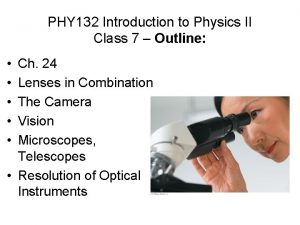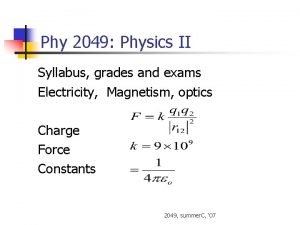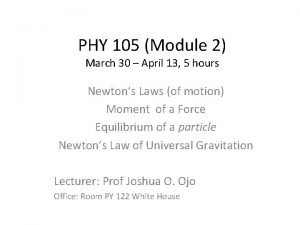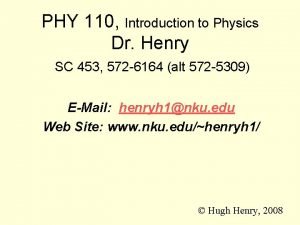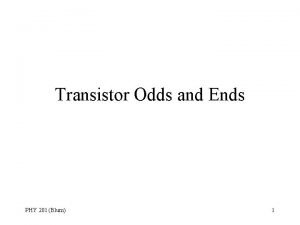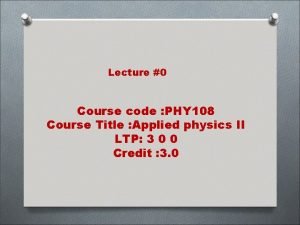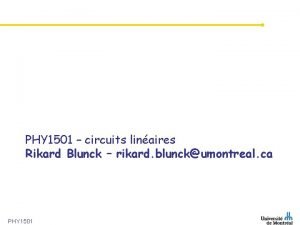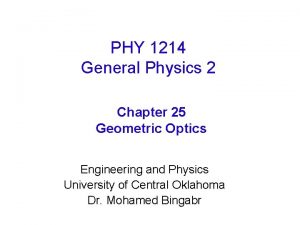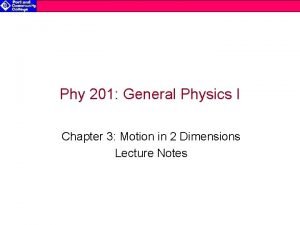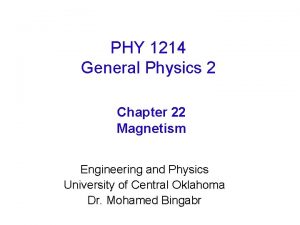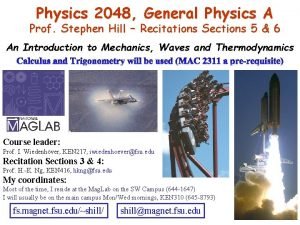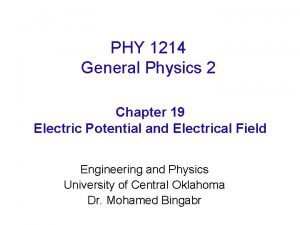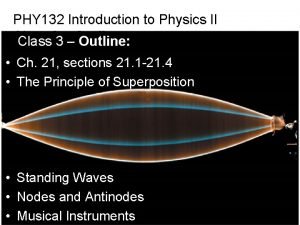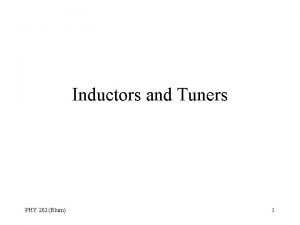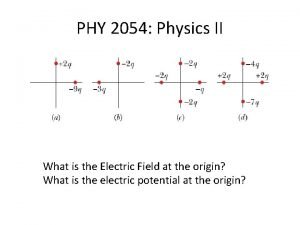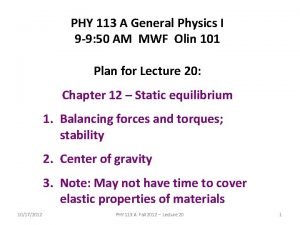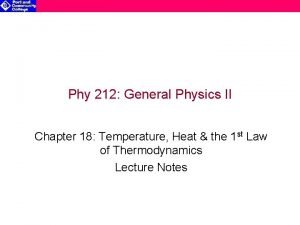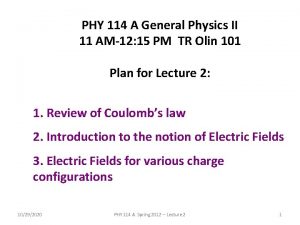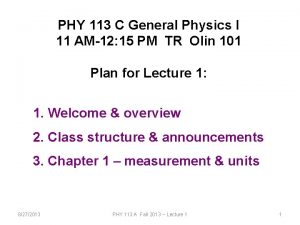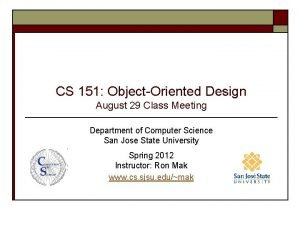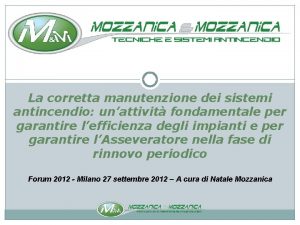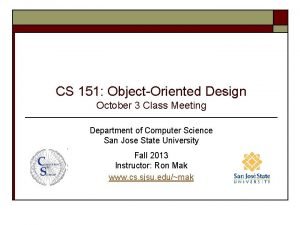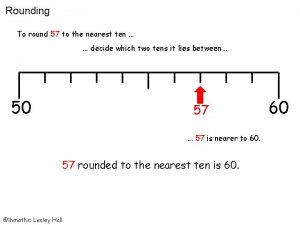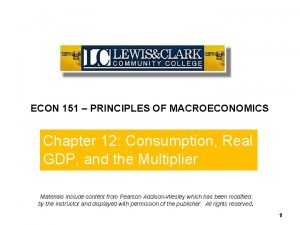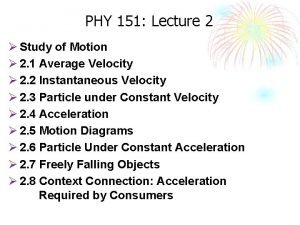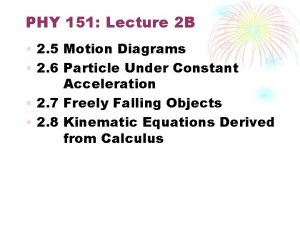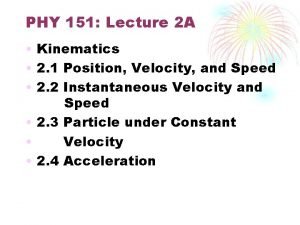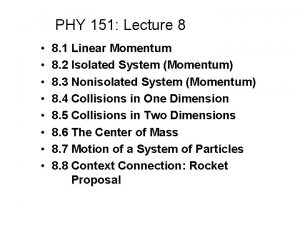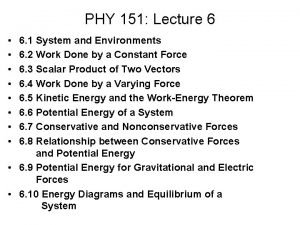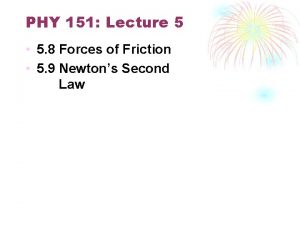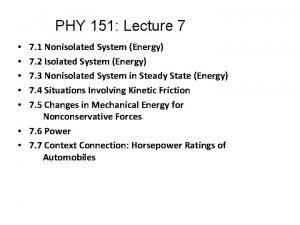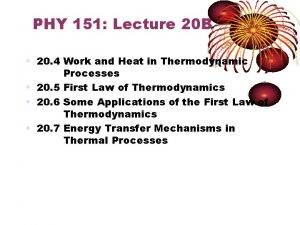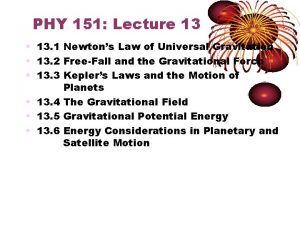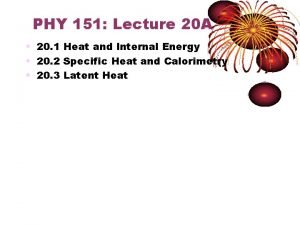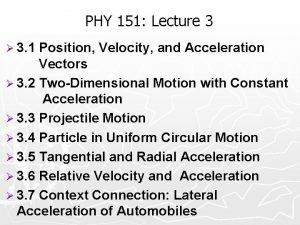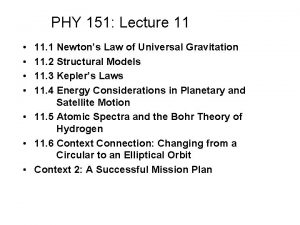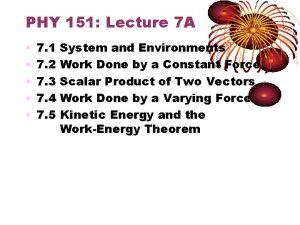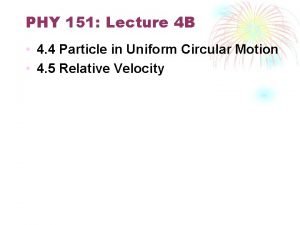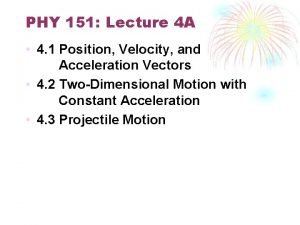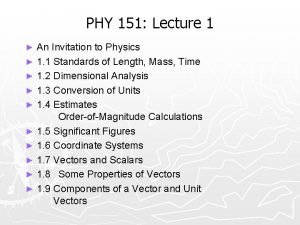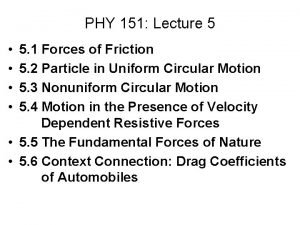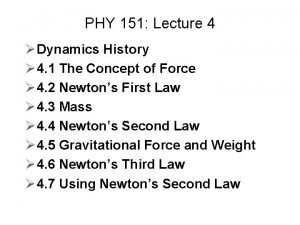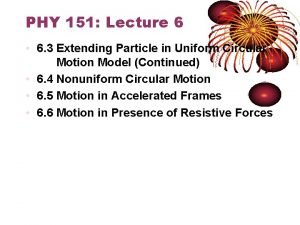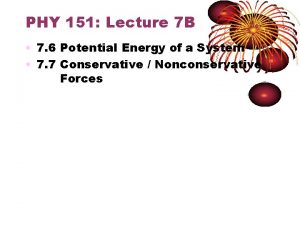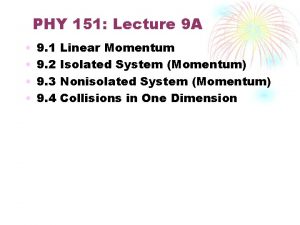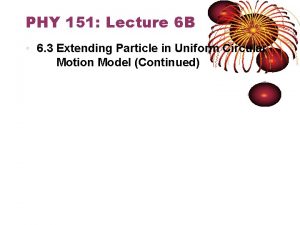PHY 151 Lecture 12 12 1 Motion of






















































- Slides: 54

PHY 151: Lecture 12 • • 12. 1 Motion of an Object attached to a Spring 12. 2 Particle in Simple Harmonic Motion 12. 3 Energy of the Simple Harmonic Oscillator 12. 4 The Simple Pendulum 12. 5 The Physical Pendulum 12. 6 Damped Oscillations 12. 7 Forced Oscillations 12. 8 Context Connection: Resonance in Structures

PHY 151: Lecture 12 Oscillatory Motion 12. 1 Motion of an Object Attached to a Spring

Motion of an Object Attached to a Spring - 1 • Periodic motion is the motion of an object that regularly repeats • The object returns to a given position after a fixed time interval • A special kind of periodic motion occurs in mechanical systems when the force acting on the object is proportional to the position of the object relative to some equilibrium position • If the force is always directed toward the equilibrium position, the motion is called simple harmonic motion

Motion of an Object Attached to a Spring - 2 • A block of mass m is attached to a spring, the block is free to move on a frictionless horizontal surface • When the spring is neither stretched nor compressed, the block is at the equilibrium position

Motion of an Object Attached to a Spring- 3 • Hooke’s Law states • Fs is the linear restoring force • It is always directed toward the equilibrium position • Therefore, it is always opposite the displacement from equilibrium – k is the force (spring) constant – x is the displacement

Motion of an Object Attached to a Spring - 4 • The block is displaced to the right of x = 0 • The position is positive • The restoring force is directed to the left

Motion of an Object Attached to a Spring - 5 • The block is at the equilibrium position • x=0 • The spring is neither stretched nor compressed • The force is zero

Motion of an Object Attached to a Spring - 6 • The block is displaced to the left of x = 0 • The position is negative • The restoring force is directed to the right

Motion of an Object Attached to a Spring - 7 • The force described by Hooke’s law is the net force in Newton’s second law

Motion of an Object Attached to a Spring - 8 • The acceleration is proportional to the displacement of the block • The direction of the acceleration is opposite the direction of the displacement from equilibrium • An object moves with simple harmonic motion whenever its acceleration is proportional to its position and is oppositely directed to the displacement from equilibrium

Motion of an Object Attached to a Spring - 9 • The acceleration is not constant, so kinematic equations cannot be applied • If the block is released from some position = A, then the initial acceleration is –k. A/m • Its speed is zero – When the block passes through the equilibrium position, a = 0 • Its speed is a maximum – The block continues to x = –A where its acceleration is +k. A/m x

Motion of an Object Attached to a Spring - 10 • The block continues to oscillate between –A and +A – These are turning points of the motion • The force is conservative • In the absence of friction, the motion will continue forever – Real systems are generally subject to friction, so they do not actually oscillate forever

PHY 151: Lecture 12 Oscillatory Motion 12. 2 Particle in Simple Harmonic Motion

Particle in Simple Harmonic Motion - 1 • Simple harmonic motion can be represented mathematically: • So • Let • Then

Particle in Simple Harmonic Motion - 2 • A function that satisfies the equation is needed • Need a function x(t) whose second derivative is the same as the original function with a negative sign and multiplied by w 2 • The sine and cosine functions meet these requirements

Particle in Simple Harmonic Motion - 3 • A solution is • A, w, f are all constants • A cosine curve can be used to give physical significance to these constants

Particle in Simple Harmonic Motion - 4 • A is the amplitude of the motion • This is the maximum position of the particle in either the positive or negative direction • w is called the angular frequency • Units are rad/s • f is the phase constant or the initial phase angle • We can now define a new analysis model: • the particle in simple harmonic motion model

Particle in Simple Harmonic Motion - 5 • A and f are determined uniquely by the position and velocity of the particle at t = 0 • If the particle is at x = A at t = 0, then f = 0 • The phase of the motion is the quantity (w t + f ) • x (t) is periodic and its value is the same each time wt increases by 2 radians

Particle in Simple Harmonic Motion - 6 • The period, T, is the time interval required for the particle to go through one full cycle of its motion • The values of x and v for the particle at time t equal the values of x and v at t + T

Particle in Simple Harmonic Motion -7 • The inverse of the period is called the frequency • The frequency represents the number of oscillations that the particle undergoes per unit time interval • Units are cycles per second = hertz (Hz)

Particle in Simple Harmonic Motion- 8 • The frequency and period equations can be rewritten to solve for w • The period and frequency can also be expressed as

Particle in Simple Harmonic Motion - 9 • The frequency and the period depend only on the mass of the particle and the force constant of the spring • They do not depend on the parameters of motion • The frequency is larger for a stiffer spring (large values of k) and decreases with increasing mass of the particle

Particle in Simple Harmonic Motion - 10 • The equations are:

Particle in Simple Harmonic Motion - 11 • Because the sine and cosine functions oscillate between ± 1, we can find the maximum values of velocity and acceleration for an object in SHM:

Particle in Simple Harmonic Motion - 12 • The graphs show: (a) displacement as a function of time (b) velocity as a function of time (c ) acceleration as a function of time • The velocity is 90 o out of phase and the acceleration is 180 o out of phase with the displacement

Particle in Simple Harmonic Motion - 13 • Consider a block set into motion by pulling it from equilibrium by a distance A and releasing it from rest at t = 0

Particle in Simple Harmonic Motion - 14 Initial conditions: x(0)= A; v(0) = 0 • This means f = 0 – The acceleration reaches extremes of ±w 2 A – The velocity reaches extremes of ±w. A

Particle in Simple Harmonic Motion - 15 • Consider an oscillating block-spring system • We define t = 0 as the instant the block passes through the unstretched position of the spring while moving to the right

Particle in Simple Harmonic Motion - 16 Initial conditions: x(0)= 0; v(0) = vi • This means f = ± /2 – Because initial velocity and amplitude are positive:

Example 12. 1 A 200 -g block connected to a light spring for which the force constant is 5. 00 N/m is free to oscillate on a frictionless, horizontal surface. The block is displaced 5. 00 cm from equilibrium and released from rest.

Example 12. 1 (A) Find the period of its motion • Find the angular frequency: • Find the period:

Example 12. 1 (B) Determine the maximum speed of the block. • Find vmax: (C) What is the maximum acceleration of the block? • Find amax:

Example 12. 1 (D) Express the position, velocity, and acceleration as functions of time in SI units. • Find the phase constant: • Write an expression for x(t): • Write an expression for v(t): • Write an expression for a(t):

Example 12. 2 A car with a mass of 1300 kg is constructed so that its frame is supported by four springs. Each spring has a force constant of 20 000 N/m. Two people riding in the car have a combined mass of 160 kg. Find the frequency of vibration of the car after it is driven over a pothole in the road.

Example 12. 2 • Find an expression for the total force on the car: • Evaluate the effective spring constant: • Find the frequency of vibration:

PHY 151: Lecture 12 Oscillatory Motion 12. 3 Energy of the Simple Harmonic Oscillator

Energy of the Simple Harmonic Oscillator - 1 • Assume a spring-mass system is moving on a frictionless surface • This is an isolated system, so the total energy is constant • The kinetic energy is • The elastic potential energy is

Energy of the Simple Harmonic Oscillator - 2 • The total energy is • Using sin 2 + cos 2 = 1:

Energy of the Simple Harmonic Oscillator - 3 • The total mechanical energy is proportional to the square of the amplitude • Energy is continuously being transferred between potential energy stored in the spring and the kinetic energy of the block

Energy of the Simple Harmonic Oscillator - 4 • Energy can be used to find the velocity:

Energy of the Simple Harmonic Oscillator - 5

Example 12. 3 A 0. 500 -kg cart connected to a light spring for which the force constant is 20. 0 N/m oscillates on a frictionless, horizontal air track.

Example 12. 3 (A) Calculate the maximum speed of the cart if the amplitude of the motion is 3. 00 cm. • Equate the total energy to the kinetic energy when cart is at x = 0: • Solve for vmax and substitute numerical values:

Example 12. 3 (B) What is the velocity of the cart when the position is 2. 00 cm? • Evaluate the velocity:

Example 12. 3 (C) Compute the kinetic and potential energies of the system when the position of the cart is 2. 00 cm. • Evaluate the kinetic energy: • Evaluate the elastic potential energy:

PHY 151: Lecture 12 Oscillatory Motion 12. 4 The Simple Pendulum

The Simple Pendulum - 1 • A simple pendulum also exhibits periodic motion • Consists of an object of mass m suspended by a light string or rod of length L • The upper end of the string is fixed • When the object is pulled to the side and released, it oscillates about the lowest point, which is the equilibrium position • The motion occurs in the vertical plane and is driven by the gravitational force

The Simple Pendulum - 2 • Equation of motion in the tangential direction is which reduces to

The Simple Pendulum - 3 • Assuming is small, use the small angle approximation (sin » ): • The angular frequency is • The period is

Simple Pendulum - 4 • The period and frequency of a simple pendulum depend only on the length of the string and the acceleration due to gravity • The period is independent of the mass • All simple pendula that are of equal length and are at the same location oscillate with the same period

Example 12. 4 Christian Huygens (1629– 1695), the greatest clockmaker in history, suggested that an international unit of length could be defined as the length of a simple pendulum having a period of exactly 1 s. How much shorter would our length unit be if his suggestion had been followed? – Solve for length and substitute values:

PHY 151: Lecture 12 Oscillatory Motion 12. 5 The Physical Pendulum Skipped

PHY 151: Lecture 12 Oscillatory Motion 12. 6 Damped Oscillations Skipped

PHY 151: Lecture 12 Oscillatory Motion 12. 7 Forced Oscillations Skipped
 What is farsightedness called
What is farsightedness called 01:640:244 lecture notes - lecture 15: plat, idah, farad
01:640:244 lecture notes - lecture 15: plat, idah, farad Life phy
Life phy Phy theorem
Phy theorem Phy 2049
Phy 2049 Phy 1214
Phy 1214 Phy-105 5 discussion
Phy-105 5 discussion Phy 205
Phy 205 Phy 110
Phy 110 Pa msu
Pa msu Phy
Phy Phy
Phy Phy108
Phy108 Phy circuit
Phy circuit Phy 113 past questions and answers
Phy 113 past questions and answers Phy 1214
Phy 1214 Eye phy
Eye phy Phy 1214
Phy 1214 The great orthogonality theorem
The great orthogonality theorem Phy
Phy Atm basics
Atm basics Phy tgen
Phy tgen General physics
General physics Phy 121 asu
Phy 121 asu Loncapa fsu
Loncapa fsu Phy 1214
Phy 1214 Phy 2049
Phy 2049 Phy 132
Phy 132 Rotational statics
Rotational statics Felix connects a wire coil to an ammeter
Felix connects a wire coil to an ammeter Fizik ii
Fizik ii 2012 phy
2012 phy Ddr phy architecture
Ddr phy architecture Phy 212
Phy 212 Phy
Phy Phy 131 past papers
Phy 131 past papers Physics 2
Physics 2 Phy 1214
Phy 1214 Cs 151 sjsu
Cs 151 sjsu 1,151,725 bytes
1,151,725 bytes Chemistry 151 final exam
Chemistry 151 final exam Scia antincendio esempio
Scia antincendio esempio Tổng kết vốn từ 151
Tổng kết vốn từ 151 Csc 151∘
Csc 151∘ 151 food
151 food Model-netics
Model-netics Econ 151
Econ 151 Item 151
Item 151 118/151
118/151 Melissa reedy uiuc
Melissa reedy uiuc Conforme a tua infinita graça numero
Conforme a tua infinita graça numero Sjsu cs 151
Sjsu cs 151 Alan ableson queens
Alan ableson queens Round of 57
Round of 57 Gdp formula
Gdp formula
